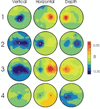Electroencephalographic (EEG) control of three-dimensional movement
- PMID: 20460690
- PMCID: PMC2907523
- DOI: 10.1088/1741-2560/7/3/036007
Electroencephalographic (EEG) control of three-dimensional movement
Abstract
Brain-computer interfaces (BCIs) can use brain signals from the scalp (EEG), the cortical surface (ECoG), or within the cortex to restore movement control to people who are paralyzed. Like muscle-based skills, BCIs' use requires activity-dependent adaptations in the brain that maintain stable relationships between the person's intent and the signals that convey it. This study shows that humans can learn over a series of training sessions to use EEG for three-dimensional control. The responsible EEG features are focused topographically on the scalp and spectrally in specific frequency bands. People acquire simultaneous control of three independent signals (one for each dimension) and reach targets in a virtual three-dimensional space. Such BCI control in humans has not been reported previously. The results suggest that with further development noninvasive EEG-based BCIs might control the complex movements of robotic arms or neuroprostheses.
Figures






References
-
- Andersen RA, Musallam S, Pesaran B. Selecting signals for a brain-machine interface. Curr. Opin. Neurobio. 2004;14:720–726. - PubMed
-
- Brown L, editor. The New Shorter Oxford English Dictionary. Vol. 2. Oxford: Clarenden Press; 1993. p. 2882.
-
- Bullmore E, Sporns O. Complex brain networks: graph theoretical analysis of structural and functional systems. Nature Reviews: Neuroscience. 2009;10:186–198. - PubMed
Publication types
MeSH terms
Grants and funding
LinkOut - more resources
Full Text Sources
Other Literature Sources
Medical
